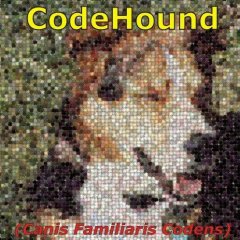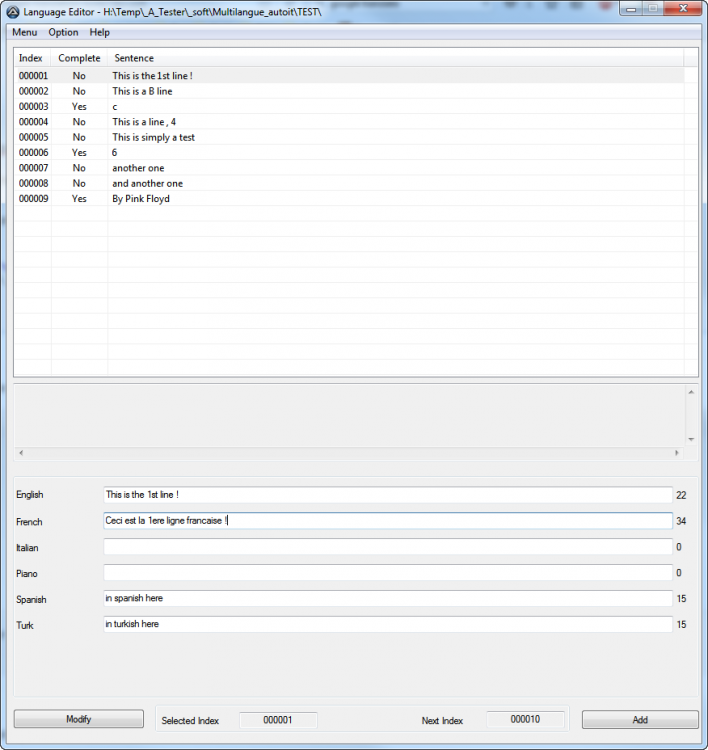Search the Community
Showing results for tags 'translation'.
-
CodeCrypter enables you to encrypt scripts without placing the key inside the script. This is because this key is extracted from the user environment at runtime by, for example: password user query any macro (e.g., @username) any AutoIt function call any UDF call some permanent environment variable on a specific machine (and not created by your script) a server response a device response anything else you can think of, as long as it's not stored in the script any combination of the above You need several scripts to get this to work, and they are scattered over several threads, so here's a single bundle that contains them all (including a patched version of Ward's AES.au3; with many thanks to Ward for allowing me to include this script here): Latest version: 3.4 (3 Dec 2021): please follow this link. Note: if you experience issues under Win8/8.1 (as some users have reported), please upgrade to Win10 (or use Win7) if you can; as far as I can tell, the scripts in the bundle all work under Win7 & Win10 (and XP). Moreover, I have no access to a Win8 box, so these issues will not be fixed, at least not by yours truly. How the bits and pieces fit together: CodeCrypter is a front-end for the MCF UDF library (you need version 1.3 or later). Its thread is here: '?do=embed' frameborder='0' data-embedContent>> The MCF package (also contained in the CodeScannerCrypter bundle) contains MCF.au3 (the library itself) plus a little include file called MCFinclude.au3. The latter you have to include in any script you wish to encrypt. Any code preceding it will not be encrypted, any code following it will be encrypted. You define the dynamic key inside MCFinclude.au3, in the UDF: _MCFCC_Init(). From the same post you can download an MCF Tutorial which I heartily recommend, because encrypting a script requires a number of steps in the right order, namely: In MCFinclude.au3, define and/or choose your dynamic key(s) (skip this step = use default setting) include MCFinclude.au3 in your target script Run CodeScanner (version 2.3+) on your target script, with setting WriteMetaCode=True (see '?do=embed' frameborder='0' data-embedContent>>), then close CodeScanner. Start CodeCrypter press the Source button to load your target file enable Write MCF0 (tick the first option in Main Settings) Enable "Encrypt" (last option in the Main Settings) Go to the Tab Encrypt and set up the encryption the way you want (skip this = use default settings) Return to Main Tab and press "Run" if all goes well, a new script called MCF0test.au3 is created in the same directory as your target. It has no includes and no redundant parts. Please check that it works as normal. (see Remarks if not) It all sounds far more complicated than it is, really. Not convinced? Check out: a simple HowTo Guide: HowToCodeCrypt.pdf an updated and extended Q & A pdf (FAQ, also included in the bundle) to help you get started:CodeCrypterFAQ.pdf For additional explanations/examples in response to specific questions by forum members (how it works, what it can/cannot do), see elsewhere in this thread, notably: Simple analogy of how it works: post #53, second part General Explanation and HowTo: post #9, 51, 75, 185/187, 196, 207, 270, 280 (this gets a bit repetitive) BackTranslation: post #179 Obfuscation: post #36 (general), 49 (selective obfuscation) Specific features and fixes: post #3 (security), 84 (redefining the expected runtime response), 169 (Curl Enum fix), 185/187 (using license keys), 194 (replacing Ward's AES UDF with different encryption/decryption calls), 251 (AV detection issue), 262 (extract key contents to USB on different target machine prior to encryption) Limitations: post #26 (@error/@extended), 149 (FileInstall), 191 (AES.au3 on x64) Not recommended: post #46/249 (static encryption), 102 (programme logic error), 237 (parsing password via cmdline) Technical notes: BackTranslation is a test to check that the MetaCode translation worked. Skip it at your peril. It also turns your multi-include composite script into a single portable file without redundant parts (you can opt to leave the redundant parts in, if you want). CodeCrypter can also obfuscate (vars and UDF names) and replace strings, variable names and UDF names with anything else you provide, for example, for language translation). After CodeScanner separates your target's structure from its contents, CodeCrypter (actually MCF, under the hood) can change any part, and then generate a new script from whichever pieces you define. See the MCF Tutorial for more explanation and examples. Encryption currently relies on Ward's excellent AES UDF and TheXman's sophisticated CryptoNG bundle. You can replace these with any other algorithm you like (but this is not trivial to do: edit MCFinclude.au3 UDF _MCFCC(), and MCF.au3 UDF _EncryptEntry(), see post #194 in this thread). AES by Ward, and CryptoNG by TheXman are also included in the bundle (with many thanks to Ward and TheXman for graciously allowing me to republish their outstanding work). Going to lie down now... RT
- 425 replies
-
- encryption
- metacode
-
(and 3 more)
Tagged with:
-
AU3Text.au3 v1.0 An extensive UDF to ease the internationalization of AutoIt scripts and programs. Add multi-lingual support to your scripts and programs in a consistent and portable manner. Main features: Store messages in a human-readable INI format.Organize messages in different categories.Handle singular and plural string variants at run time.Expands meta-characters and all AutoIt macro's.Supports UTF-16 Little-Endian encoding.GUI Menu and Combo Create/Read helper functions.Command line utility to extract messages from AutoIt scripts.Fully portable!The download contains the following files:ReadMe.txt Instructions and information on the UDF. AU3Text-HowTo.txt Step by step instructions to convert programs for internationalization with AutoIt. AU3Text-Demo.au3 AU3Text demo. AU3Text-Extractor.au3 Source file for command line utility to extract AU3Text messages from scripts. You'll need to compile this script before you can use it. This is BETA software! LibAU3Text.au3 Main AU3Text library. LibAU3TextGUI.au3 AU3Text GUI helpers. LibAU3TextDev.au3 Additional developer functions. LibLocale.au3 Locale functions. Originally based on guinness' excellent _GetOSLanguage function, but has grown into a full stand-alone UDF. LibIni.au3 UTF-16 LE INI functions. LibStringFormatEx.au3 Modified StringFormat function. See http://www.autoitscript.com/forum/topic/139260-autoit-snippets/page__st__60#entry1010824 I18nAU3Text-Demo.en.lng English demo language file. I18nAU3Text-Demo.nl.lng Dutch demo language file. I18nAU3Text-Translation-HowTo.txt Basic translation instructions. ResAU3Text-Extractor.ico Pic unrelated :)A simple example of translating a string: #include 'LibAU3Text.au3' _AU3Text_BindTextSection('MESSAGES', 'nl') ; Set translations to dutch. ; ... Create a GUI. ; Translate a string: GUICtrlCreateLabel(_AU3Text('The flying dutchman flies again.', 'FLYING_DUTCHMAN'), -1, -1) ; De vliegende hollander vliegt alweer. ; Translate a string with plural variants: GUICtrlCreateLabel(StringFormat(_AU3Text_Plural('Deleted %i file.', 2, 'DELETED_FILES'), 2), -1, -1) ; 2 bestanden verwijdert. ; Using shorthand functions: GUICtrlCreateLabel(_('The flying dutchman flies again.', 'FLYING_DUTCHMAN'), -1, -1) GUICtrlCreateLabel(StringFormat(_P('Deleted %i file.', 2, 'DELETED_FILES'), 2), -1, -1) ; Let AU3Text generate the INI keys, keys are MD5 hashes of the messages. GUICtrlCreateLabel(_('The flying dutchman flies again.'), -1, -1) GUICtrlCreateLabel(StringFormat(_P('Deleted %i file.', 2), 2), -1, -1) ; ...The UDF: AU3Text.zip If you encounter any bugs or have any suggestions, requests or improvements, then please let me know. Happy coding! edit 1: zip added edit 2: If you compiled AU3Text-Extractor and want to test it, run it against AU3Text-Demo like this: AU3Text-Extractor.exe Au3Text-Demo.au3 beThis will create AU3Text-Demo.be.lng in the I18n directory.
- 14 replies
-
- internationalization
- i18n
-
(and 6 more)
Tagged with:
-
MetaCode offers a way to: separate a script's structure from its content remove all redundant definitions (globals and UDFs) change any content (and some structure) combine (new) structure and (new) content into a new script The most useful applications implemented so far are: Fast language translation (not just text strings, also variable names and UDF names) Obfuscation (vars and/or UDFs) Script Encryption (conditionals, calls, and macros) Encryption is powerful because the key is not stored anywhere; you can define it to be a user password, macro, environment spec/variable, server response, something you define yourself, or a combination thereof; anything goes, as long as it's not a fixed string or fixed value. More info in the CodeCrypter thread: ?do=embed' frameborder='0' data-embedContent>'?do=embed' frameborder='0' data-embedContent>> ?do=embed' frameborder='0' data-embedContent> But MetaCode has more potential than that; it allows you to tinker with any type of content separately, then rebuild a new version. So for example, you can have a single script structure and numerous different language modules you just plug in to create a new version in a different language. A brief Tutorial is here: MetaCode Tutorial.pdf The MCF library itself can be found in the CodeScannerCrypter bundle. And a little example how to use it for translating your GUI into a different language: UI_Translator.7z (new version that should work with the new version of Google Translate, see post #13 below) MCF.au3 is just the library plus the MCFinclude.au3 file you need to include in any script you wish to encrypt. There is no GUI here. However, I did write a separate front-end for it called CodeCrypter, which you can find here: ?do=embed' frameborder='0' data-embedContent>'?do=embed' frameborder='0' data-embedContent>> ?do=embed' frameborder='0' data-embedContent> MCF uses output generated by my CodeScanner version 2.8+, which you can find here: '?do=embed' frameborder='0' data-embedContent>> CodeScanner also depends on MCF.au3 now, as it can now call a few of its functions. I should also mention Ward's excellent AES.au3 UDFs used for the encryption and decryption calls, which is now included in the CodeScannerCrypter bundle (thanks to Ward for allowing to include it). You can find the original (unpatched) version here: '?do=embed' frameborder='0' data-embedContent>> Note: you can replace the encryption/decryption calls with whatever algorithm you like (hint: the native <Crypt.au3> library is too slow for most purposes, better stick to machine code routines) So just to be clear: CodeScanner (v2.8+) needs MCF (earlier versions won't work!) CodeCrypter needs MCF (plus anything that MCF needs) MCF itself needs MCFinclude (part of MCF zip) MCF also needs readCSdatadump (part of the CodeScanner package, you need the latest version packaged with CodeScanner v2.8; earlier versions won't work!) both MCF and MCFinclude currently rely on AES.au3 by Ward So you basically need to download the whole bundle for any of it to work. If you have any questions, please start by reading the MCF Tutorial and the CodeCrypter FAQ (you can download the latter separately from the CodeCrypter thread). Next, read the extensive Remarks sections in MCF.au3, MCFinclude.au3, and CodeCrypter.au3 If still no joy, then please post. However, I'm not online that often, and logged in to the forum even less, so response may take a while). RT
- 18 replies
-
- metacode
- translation
-
(and 2 more)
Tagged with:
-
Hey I searched code on autoit forum and modify it according to my needs and try to translate text from Russian to English in return I'm getting error such as "Error 411 (Length Required)!!1" Both my autoit codes and error I got are given below, please help me to solve this issue, Thanks Autoit codes to translate text form Russian to English; #include <urlencode.au3> $File1 = @ScriptDir & "\russian_text.txt" $txt = FileRead($File1) ; Try to convert line breaks with .....so final URL looks simpler $txt = StringReplace($txt, @CRLF, '...........') $txt = StringReplace($txt, @LF, '.............') $txt = StringReplace($txt, @CR, '.............') FileWrite (@scriptdir & '\russian_text2.txt', $txt) $openfile = @ScriptDir & "\russian_text2.txt" $mytext = FileRead ($openfile) $encoding = urlencode ($mytext) FileWrite (@scriptdir & '\enooding.txt', $encoding) $from = "ru" $to = "en" $url = "https://translate.googleapis.com/translate_a/single?client=gtx" $url &= "&sl=" & $from & "&tl=" & $to & "&dt=t&q=" & $encoding $oHTTP = ObjCreate("Microsoft.XMLHTTP") $oHTTP.Open("POST", $url, False) $oHTTP.Send() $sData = $oHTTP.ResponseText $sData = StringRegExpReplace($sData, '.*?\["(.*?)(?<!\\)"[^\[]*', "$1" & @crlf) FileWrite (@scriptdir & '\errorcode.txt', $sData) Msgbox(0,"", $sData) In response of above codes, I'm getting below error; <!DOCTYPE html> <html lang=en> <meta charset=utf-8> <meta name=viewport content="initial-scale=1, minimum-scale=1, width=device-width"> <title>Error 411 (Length Required)!!1</title> <style> *{margin:0;padding:0}html,code{font:15px/22px arial,sans-serif}html{background:#fff;color:#222;padding:15px}body{margin:7% auto 0;max-width:390px;min-height:180px;padding:30px 0 15px}* > body{background:url(//www.google.com/images/errors/robot.png) 100% 5px no-repeat;padding-right:205px}p{margin:11px 0 22px;overflow:hidden}ins{color:#777;text-decoration:none}a img{border:0}@media screen and (max-width:772px){body{background:none;margin-top:0;max-width:none;padding-right:0}}#logo{background:url(//www.google.com/images/branding/googlelogo/1x/googlelogo_color_150x54dp.png) no-repeat;margin-left:-5px}@media only screen and (min-resolution:192dpi){#logo{background:url(//www.google.com/images/branding/googlelogo/2x/googlelogo_color_150x54dp.png) no-repeat 0% 0%/100% 100%;-moz-border-image:url(//www.google.com/images/branding/googlelogo/2x/googlelogo_color_150x54dp.png) 0}}@media only screen and (-webkit-min-device-pixel-ratio:2){#logo{background:url(//www.google.com/images/branding/googlelogo/2x/googlelogo_color_150x54dp.png) no-repeat;-webkit-background-size:100% 100%}}#logo{display:inline-block;height:54px;width:150px} </style> <a href=//www.google.com/><span id=logo aria-label=Google></span></a> <p><b>411.</b> <ins>That’s an error.</ins> <p>POST requests require a <code>Content-length</code> header. <ins>That’s all we know.</ins>
- 10 replies
-
- translator
-
(and 3 more)
Tagged with:
-
Hi, Here is a tool coded in AutoIt to edit multiple ini files ( up to 8 at the same time) to include multilanguage support in your script. The script himself have multilanguage support, simply by using : To change language, i read my global.ini file witch inform me what ini file i had to use... ConsoleWrite ( _string_lang(19) ) Func _string_lang($number) $number = _StringRepeat("0",6-StringLen($number)) & $number $string = IniRead($my_ini_folder & $interface_ini_file,"STRING",$number,"NOT_FOUND") Return($string) EndFunc where 19 is the 19 string in ini file witch look like this : Todo : Initial ini file not necessarily "english.ini" Feel free to use it, give me idea, critical or bug found..... As i am french please be gently Multilangue_autoit.zip
-
- translation
- translate
-
(and 1 more)
Tagged with:
-
For some obvious reason, Sucessfully to translate an #computing padding algorithm, and outputting same value with example of an explanation Lets take a breath, wiki say: The following formulas provide the number of padding bytes required to align the start of a data structure (where mod is the modulo operator): # pseudo-code, see actual code below padding = (align - (offset mod align)) mod align new offset = offset + padding = offset + (align - (offset mod align)) mod align For example, the padding to add to offset 0x59d for a structure aligned to every 4 bytes is 3. The structure will then start at 0x5a0, which is a multiple of 4. Note that when offset already is a multiple of align, the second modulo in (align - (offset mod align)) mod align is required to get a padding of 0. Then I write AutoIt3 script. ConsoleWrite(@CR & '+ Computing padding' & @CR) Local $align, $offset, $padding, $new_offset $align = 4 $offset = 0x59d $padding = Mod($align - Mod($offset, $align), $align) $new_offset = $offset + $padding + Mod($offset + ($align - Mod($offset, $align)), $align) ConsoleWrite('padding: ' & $padding & ' new offset: 0x' & StringLower(Hex($new_offset, 4)) & @CR) And the output is match with example in explanation. + Computing padding padding: 3 new offset: 0x05a0 The question #01 are is that are correct translation? changing second line on second (=) (see below) with plus sign (+) in AutoIt3 (see above) ? new offset = offset + padding = offset + (align - (offset mod align)) mod align . Again lets take a breath, wiki say: If the alignment is a power of two, the modulo operation can be reduced to a bitwise boolean AND operation. The following formulas provide the new offset (where & is a bitwise AND and ~ a bitwise NOT): padding = align - (offset & (align - 1)) = (-offset) & (align - 1) new offset = (offset + align - 1) & ~(align - 1) Then I write AutoIt3 script. ConsoleWrite(@CR & '+ align 2 - Power of Two' & @CR) Local $align, $offset, $padding, $new_offset $align = 2 $offset = 0x59d $padding = $align - (BitAND($offset, ($align - 1))) + BitAND((-$offset), ($align - 1)) $new_offset = BitAND(($offset + $align - 1), BitNOT($align - 1)) ConsoleWrite('padding: ' & $padding & ' new offset: 0x' & StringLower(Hex($new_offset, 4)) & @CR) And the output is. + align 2 - Power of Two padding: 2 new offset: 0x059e The question #02. First line and second (=) I replace with plus (+) sign, again is that correct? The question #03. What is meaning from the word of 'The Power of Two'? Are 2 is The Power of Two? Are 4, 8, 16 is The Power of Two? Which are the number are is The Power of Two and which is not? Can someone give me an confirmation if translation that pseudo-code to AutoIt3 are correct.? Can someone give me an explanation what is so called 'The Power of Two'.? Please answer even if you think this are childish question, because I'm not from Brittain nor from American.
- 2 replies
-
- algorithm
- translation
-
(and 2 more)
Tagged with:






